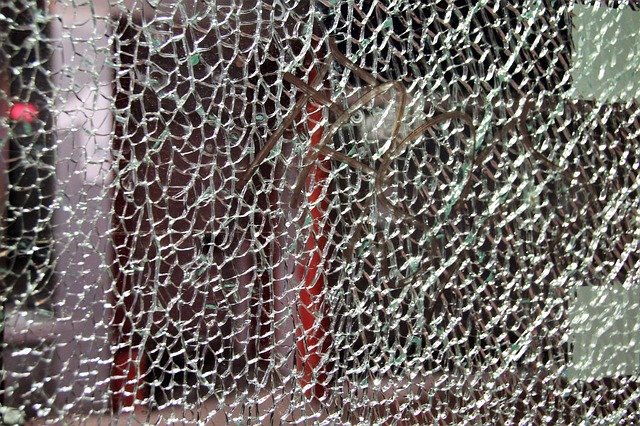Safety glass
The term safety glass refers to a range of glass types that have been strengthened or reinforced to make them less susceptible to breakage or shattering and to make them safer when they are broken. Safety glass should not splinter into large shards when broken.
Types of safety glass include:
- Toughened glass which has been tempered. When smashed it shatters into small, rounded pieces. Tempered glass is annealed glass that has been retreated in a heating and rapid cooling process to make it harder and stronger. As a result, it is four times stronger than annealed glass but also more expensive. For more information see: Tempered glass.
- Laminated glass. Comprises plastic interlayers sandwiched by sheets of glass. When struck, it may crack, but the glass is held in place by the plastic.
- Reinforced glass such as wired glass. Glass reinforced with a wire mesh. When struck, the glass cracks but does not shatter. It can also be fire resistant.
In buildings, safety glass may be used to withstand objects that might impact the glass, or to remain safe if it is broken when impacted. It is typically used for large glazed areas and wherever glass is required in a position that makes it vulnerable to being struck by objects or people, and where the result could be serious injury or damage. A typical application is low-level glass which could be impacted by children, but also glazed doors and shower screens, glass balustrades, glass walls etc.
Part N of the Approved Documents to the Building Regulations deals with the requirements for safety glass. It requires safety glass to satisfy one of the following conditions:
- Where people moving in or about the building are likely to come into contact or impact the glass.
- If broken on impact, the glass should break in a way which is unlikely to cause injury.
- Resist impact without breaking.
- Be shielded or protected from impact.
In non-domestic applications, where glazing is transparent, it should incorporate features e.g markings, transfers etc, which make it apparent to people who are likely to impact it when moving in or about the building (manifestation).
See also: Security glazing.
[edit] Related articles on Designing Buildings Wiki
Featured articles and news
RTPI leader to become new CIOB Chief Executive Officer
Dr Victoria Hills MRTPI, FICE to take over after Caroline Gumble’s departure.
Social and affordable housing, a long term plan for delivery
The “Delivering a Decade of Renewal for Social and Affordable Housing” strategy sets out future path.
A change to adoptive architecture
Effects of global weather warming on architectural detailing, material choice and human interaction.
The proposed publicly owned and backed subsidiary of Homes England, to facilitate new homes.
How big is the problem and what can we do to mitigate the effects?
Overheating guidance and tools for building designers
A number of cool guides to help with the heat.
The UK's Modern Industrial Strategy: A 10 year plan
Previous consultation criticism, current key elements and general support with some persisting reservations.
Building Safety Regulator reforms
New roles, new staff and a new fast track service pave the way for a single construction regulator.
Architectural Technologist CPDs and Communications
CIAT CPD… and how you can do it!
Cooling centres and cool spaces
Managing extreme heat in cities by directing the public to places for heat stress relief and water sources.
Winter gardens: A brief history and warm variations
Extending the season with glass in different forms and terms.
Restoring Great Yarmouth's Winter Gardens
Transforming one of the least sustainable constructions imaginable.
Construction Skills Mission Board launch sector drive
Newly formed government and industry collaboration set strategy for recruiting an additional 100,000 construction workers a year.
New Architects Code comes into effect in September 2025
ARB Architects Code of Conduct and Practice available with ongoing consultation regarding guidance.
Welsh Skills Body (Medr) launches ambitious plan
The new skills body brings together funding and regulation of tertiary education and research for the devolved nation.
Paul Gandy FCIOB announced as next CIOB President
Former Tilbury Douglas CEO takes helm.
UK Infrastructure: A 10 Year Strategy. In brief with reactions
With the National Infrastructure and Service Transformation Authority (NISTA).























